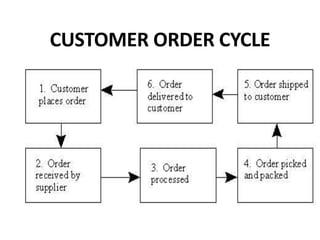In the fast-paced world of global commerce, the seamless flow of goods from manufacturer to consumer relies on a well-oiled machine known as the order cycle. At the heart of this intricate system lies the vital components of logistics, transport, and shipping. In this article, we will delve into the intricate layers of the order cycle and explore the key role these elements play in ensuring the efficient movement of products from point of origin to final destination. Join us on a journey through the intricate web of supply chain management and discover the art of orchestrating the perfect delivery.
Understanding the Order Cycle in Logistics
is crucial for businesses to ensure efficient transportation and shipping processes. The order cycle encompasses all the steps involved in fulfilling a customer’s order, from the moment it is placed to the moment it is delivered. By having a clear understanding of the order cycle, businesses can streamline their operations, reduce costs, and improve customer satisfaction.
In logistics, the order cycle typically includes the following key steps:
- Order placement
- Order processing
- Inventory management
- Picking and packing
- Shipping and transportation
- Delivery
Each step in the order cycle plays a vital role in ensuring that orders are fulfilled accurately and on time. By optimizing each of these steps, businesses can minimize delays, errors, and costs associated with the order fulfillment process. By focusing on improving the order cycle, businesses can enhance their overall efficiency and competitiveness in the market.
The Role of Transport in Efficient Shipping
Efficient shipping relies heavily on the role of transport in the order cycle logistics. Transport plays a crucial part in ensuring that goods are moved from one point to another in a timely manner, meeting customer demands and expectations. Whether it’s by land, sea, or air, the choice of transportation mode can greatly impact the efficiency of the shipping process.
Transportation also plays a significant role in determining the cost of shipping. By optimizing transport routes and modes, businesses can minimize expenses and improve their bottom line. Additionally, the reliability of transport services is key in maintaining smooth operations and meeting delivery deadlines. With the right transport strategies in place, businesses can streamline their shipping processes and provide a better customer experience.

Maximizing Efficiency through Streamlined Shipping Processes
In today’s fast-paced e-commerce world, businesses are constantly looking for ways to maximize efficiency through streamlined shipping processes. By optimizing the order cycle, logistics, transport, and shipping, companies can reduce costs, improve customer satisfaction, and stay ahead of the competition.
Logistics: Implementing a well-organized logistics strategy is crucial for minimizing delays and errors in the shipping process. This includes inventory management, warehouse optimization, and transportation planning.
Transport: Choosing the right mode of transportation can significantly impact efficiency. Whether it’s air, sea, road, or rail, each option has its own advantages and drawbacks. By selecting the most cost-effective and timely method, businesses can ensure that shipments reach customers on time and intact.

Key Recommendations for Optimizing Order Cycle Logistics
When it comes to optimizing order cycle logistics, there are several key recommendations that can help streamline the transport and shipping process. One crucial aspect is to utilize advanced technology such as transportation management systems (TMS) to automate and optimize route planning and scheduling. By leveraging TMS software, companies can minimize transit times, reduce transportation costs, and enhance overall operational efficiency.
Another important recommendation is to establish strong partnerships with reliable carriers and freight forwarders. Working closely with trusted transportation providers can help ensure on-time deliveries, improve supply chain visibility, and mitigate risks associated with delays or disruptions. Additionally, implementing a robust quality control system and real-time tracking capabilities can further enhance order cycle logistics performance and customer satisfaction.
Key Takeaways
As we conclude our exploration of the order cycle in logistics, transport, and shipping, it is evident that a seamless and efficient process is essential for the success of any business. From order placement to delivery, each step plays a crucial role in ensuring customer satisfaction and optimizing supply chain operations. By understanding the intricacies of these interconnected systems, companies can streamline their processes and minimize costs while maximizing profitability. As the world of commerce continues to evolve, staying ahead of the curve in logistics and shipping will be key to maintaining a competitive edge in the global marketplace. Thank you for joining us on this journey through the order cycle, and we hope you have gained valuable insights to apply to your own business practices. Stay tuned for more articles on the latest trends and innovations in the logistics industry.
